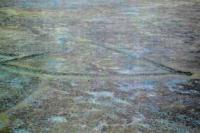Вы здесь
Arrows Ustyurt.

Destinations and routes of Ustyrt.
“If one body is a mystery to us, then what kind of mystery should the Universe be?”
E. Condillac.
Tours of historical places of Ustyurt.
Unknown “architects” who left us their stone messages seem to be sure that in thousands of years they will be easily understood. However, having reached the cosmic heights of civilization, we, apparently, simply forgot the ancient language of stones.
Eloquent evidence of this is the crushed stone calculations found by aerial photography on the Ustyurt plateau in Karakalpakstan. These "letters" are located in remote, waterless areas. Archaeologist V.N. Yagodin believes that this system is comparable in many ways with the giant signs and drawings of the Nazca desert in Peru.
Signs on the Ustyurt Plateau have one feature - most of them are “inanimate”, that is, they are not stylized drawings of recognizable representatives of the fauna, like on the Nazca Plateau, but a system of stylized figures, reminiscent of arrows, organized according to the principle unknown to us.
The tip of each “arrow” has the form of an isosceles triangle with sides up to 110 m in length, and instead of a shaft - stone arcs diverging with a comet plume up to a kilometer in length. And one more intriguing stroke: the tips of the arrows are topped with rings of the same gulliver size.
In total, 30 “arrows” were found, and all of them are based on their “loops” on an endless stone “string” covering the entire width of the plateau (about 160 km). If you mentally let go of the "bowstring", then the swarm of "arrows" will rush strictly to the northeast.
According to archeologists, the “arrows” were laid out much earlier than the settlement of a fossil man here. The parks of primitive people were discovered by the expedition of V. Yagodin much south of the swept system.
Archaeologists have found at the sites of the Mesolithic (this is about V millennium BC. E.) Stone tools Neanderthals, but the most strange discovery turned out to be bones of fossil fish. Obviously, in those days the sea was near, and then retreated, most likely, to the northeast, where today the Aral Sea.
The sea continues to "run away" now. An interesting detail: the arrows just indicate the direction of this runaway! Researchers believe that the ancient people could mark the path to the shores of the retreating sea. But you can see the image of arrows only from a bird's eye view.
If Neanderthals built a system of arrow-pointers, they had to understand the whole absurdity of the undertaking: was the titanic work done, and only birds could see it? Or ... aliens? Perhaps such a cosmic motive could have been easily refuted, but ...
Next to the arrows, the archeology enthusiast A.P. Pechersky discovered giant stones laid out by stones of unknown animals! The outlines of one of the figures A.P. Pechersky put on a map of the area. It turned out that this is an image of a colossal tortoise!
A few hundred meters away from her, there is the same monster, and the next one after it. Like the arrows, the figures are oriented to the northeast. If you go in the indicated direction, then after a few kilometers among the vast desert, a road suddenly appears...
It is laid out of the same broken stone as the arrows, absolutely straight, limited at the edges by a paling of large stones. The archaeological rebus of Ustyurt is complicated by the fact that dozens of ... pyramids were found in the same area!
True, unlike the Egyptian, they are composed of raw blocks of smaller size. What idea is embodied by the authors in these stone riddles, the construction of which required a lot of work? After all, the nearest career is a few kilometers away!
Neanderthals could hardly afford to drag thousands of tons of stones without any adaptations. To remove the aura of mystery from the finds on the Ustyurt plateau could be a new, well-equipped expedition...
Authority:
"100 Great Secrets of the East." http://sokrytoe.net/26395-zagadochnye-zodchie-ustyurta.html







